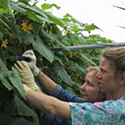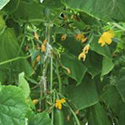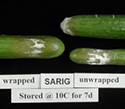Postharvest Handling Considerations
Greenhouse-Grown Beit Alpha Cucumbers
There is potential to produce the new Beit Alpha-type cucumbers under protected culture in Florida. These miniature cucumbers were developed in Israel and are similar to the Dutch greenhouse types, in that they have a thin skin and are seedless, but are significantly smaller, with ideal size ranging from about 5 to 7 inches (12.5 to 17.5 cm) in length and 3/4 to 1 1/4 inches ( 22 to 29 mm) in diameter. Tests conducted at the Florida-Israeli Protected Agriculture Project in Gainesville and at the North Florida Research & Education Center-Suwannee Valley in Live Oak have shown that these cucumbers yield well under a wide range of ambient temperatures found in greenhouses (Shaw, et al, 2001).
In order to successfully introduce a new specialty crop like Beit Alphas, consideration must be given to developing market demand and understanding postharvest handling parameters. Important aspects of developing market demand include consumer preferences (e.g., color, size, flavor) and buyer preferences (e.g., package size and weight). Key postharvest information is lacking that would allow commercial growers to successfully ship Beit Alphas to desired markets. Desirable quality parameters include firm texture, shiny, dark-green skin color, and freedom from shrivel, and mechanical injuries (abrasions, cuts, bruises). Therefore, shippers must know optimal storage conditions and cooling method, mechanical properties (resistance to compression, vibration), packaging types and threshold susceptibility to ethylene exposure. Other postharvest treatments, such as coatings, hot water immersion, and controlled/modified atmosphere storage, may also significantly extend product quality.
Recent observations of Beit Alphas at retail level showed preventable quality losses, indicating the need for information on proper handling of this new crop. Slicing-type cucumbers can be safely stored at 50 to 55oF (10 to 13oC) for 10 to 14 days, depending on the cultivar (Hardenburg, et al., 1986). To minimize moisture loss and shrivel field-grown slicing cucumbers are usually coated with wax, while Dutch greenhouse-grown types are shrink-wrapped with plastic film.
This spring we performed preliminary postharvest tests with Beit Alpha cucumbers from both research sites and a commercial greenhouse operation. Panelists in our sensory evaluations commented that the flavor was excellent. At harvest, small-diameter fruits (3/4 inch; 22 mm) were consistently firmer (from 1 to 2 Newtons) and had a noticeably crisper texture than larger-diameter fruits (1 1/4 inch; 29 mm). This indicates that smaller cucumbers may be less susceptible to mechanical injuries during handling and shipping. ‘Sarig’ cucumbers stored at 50oF (10oC) and 95% relative humidity maintained high quality for more than 14 days (Fig. 2). After 5 days storage, uncovered cucumbers lost about 50% more fresh weight than those loosely covered with plastic film. Both ‘Sarig’ and ‘Alexander’ cultivars developed chilling-injury symptoms after 7 days storage at 45.5oF (7.5oC) or 41oF (5oC). Other tests are currently underway to determine the effectiveness of waxes and shipping containers including hinged, rigid containers (clamshells).
Crops grown under protected culture can become inoculated by decay pathogens. Sources of inoculum include nearby cull piles--diseased plants and fruits should never be discarded near the greenhouse (Fig. 3). In these tests, sclerotinia rot (Sclerotinia sclerotiorum) appeared on sound, ‘Sarig’ cucumbers following 7 days storage at 50oF (10oC) (Fig. 4). Although considered a minor problem in field production of cucurbits, the growth of this aggressive rot during cold storage shows the need for preventative control measures in the greenhouse.
Cross-contamination of fresh produce by human pathogens is also a serious threat to consumers, with reliable estimates in the U.S.A. indicating that a small, but increasing percent of foodborne illness is attributable to consumption of fresh produce. Production of vegetables in greenhouse structures holds potential for reducing the risk of foodborne illness by isolating the plants from potential environmental contamination. Employees should be instructed in proper hand washing and other sanitary techniques to avoid cross-contamination during harvest and handling.
For Further Information
Hardenburg, R.E., A.E. Watada and C.Y. Wang. 1986. The commercial storage of fruits, vegetables, and florist and nursery stocks. U.S. Dept. Agric. Handbook 66. Washington DC.
Shaw, N.L., D.J. Cantliffe, J.C. Rodriguez, S. Taylor and D.M Spencer. 2001. Beit alpha cucumber - an exciting new greenhouse crop. Proc. Fla. State Hort. Soc. 113:247-253.
Authors
Steven A. Sargent, Suzanne C. Stapleton, Multi-county extension agent-marketing, NFREC-Suwannee Valley and Abbie J. Fox, Senior Biological Scientist, Horticultural Sciences Dept.




